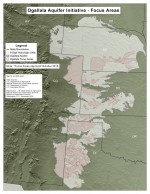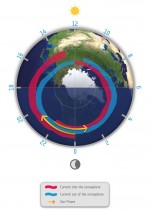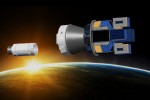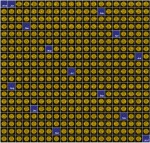
Wednesday, May 17th, 2017
Water conservation is a growing concern globally, and particularly for farmers in the United States, where decades of irrigating huge fields has depleted vital resources of fresh surface water and groundwater. To help alleviate this problem, a European Space Agency (ESA) spin-off that hopes to help preserve water supplies while guaranteeing crop irrigation is now

Tuesday, April 11th, 2017
Earth’s magnetic field is like a huge cocoon, protecting the planet from cosmic radiation and charged particles found in solar wind. European Space Agency (ESA) Swarm satellites are recording details about one of the most difficult to observe layers of Earth’s magnetic field—as well as the magnetic history imprinted on Earth’s crust. Most of Earth’s

Tuesday, March 28th, 2017
Information from the European Space Agency (ESA) magnetic field Swarm mission led to the discovery of supersonic plasma jets high up in Earth’s atmosphere that can push temperatures up to almost 10,000 degrees Celsius. Presenting these findings at the Swarm Science Meeting in Canada, scientists from the University of Calgary explained how they used measurements

Tuesday, February 28th, 2017
In the second half of 2018, the European Space Agency (ESA) Vega small launcher is set to demonstrate its extended capability to deploy multiple light satellites using its new versatile Small Satellites Mission Service (SSMS) dispenser. This demonstration provides the first of the launch opportunities under the new Light satellite, Low-cost Launch opportunity (LLLor L3)
Friday, January 20th, 2017
Stevenage, 20/01/2017- Aeolus, the European Space Agency’s wind sensing satellite, is leaving Stevenage, UK, in the next few days on the first part of its journey to space. It will be shipped to Toulouse, France, for final testing before it travels to French Guiana towards the end of the year ready for launch on a

Tuesday, January 17th, 2017
The SWAP camera onboard the European Space Agency (ESA) Proba-2 satellite takes advantage of extreme ultraviolet wavelengths to capture the hot turbulent atmosphere of the Sun’s solar corona. To illustrate what SWAP does and what it can teach, ESA and the Royal Observatory of Belgium collected and published 366 solar images—one for each day of
Monday, December 5th, 2016
“Europe’s ambitions in space have received another boost today and we applaud ESA’s decisions to furtjer develop Europe in space. European citizens will benefit greatly from our new innovative solutions,” said Nicolas Chamussy, Head of Space Systems, on decisions by ministers from the European Space Agency’s (ESA) 22 member states. At their meeting on 1-2